建筑材料的应用
建筑材料特性及应用实例

建筑材料特性及应用实例建筑材料是建筑工程中最主要的材料之一,其特性和应用范围非常广泛。
下面将以常见的建筑材料为例,介绍其特性和应用实例。
1. 水泥:水泥是建筑材料中的基础材料,主要用于混凝土和砂浆的制备。
其特性包括高强度、耐火性和耐久性,可以保证建筑物的结构稳定和长久使用。
应用实例包括大型公共建筑如桥梁、隧道以及住宅楼等。
2. 钢材:钢材是常用的结构材料,具有高强度、耐候性和可塑性的特点。
其应用范围广泛,包括钢结构框架、屋面覆盖、墙体支撑等。
例如,高层建筑、大跨度的体育场馆和桥梁等都是使用钢材建造的。
3. 玻璃:玻璃是一种透明、刚硬和易加工的材料,具有良好的光传输性能。
因此,玻璃常被用作建筑物外墙的幕墙和窗户。
此外,玻璃还能够进行特殊处理,如防火、隔热和隔音等,满足建筑的各种功能要求。
4. 砖块:砖块是建筑中最常见的材料之一,具有耐磨性、耐候性和隔热性能。
常用于墙体的建造,既可以用于室内分隔墙的建造,也可以用于外墙的建造。
砖块还可以根据不同的要求,进行装饰处理,如贴面砖、瓷砖等。
5. 木材:木材是一种天然的建筑材料,具有良好的隔热和吸声效果。
木材的应用范围非常广泛,包括木结构屋架、地板、门窗等。
由于木材资源丰富和环保,近年来木材建筑的应用越来越受到人们的关注。
6. 石材:石材是一种天然的建筑材料,具有耐久性和美观性。
石材主要用于建筑物的外部装饰,如立面饰面、门廊和台阶等。
不同种类的石材有不同的特点和应用范围,如大理石、花岗岩、石灰岩等。
7. 聚合物材料:聚合物材料包括塑料和橡胶等,其特点是重量轻、易成型和耐腐蚀性。
聚合物材料可用于建筑物的热绝缘材料、屋面防水材料以及室内装饰材料等。
此外,近年来减少环境污染的需要,聚合物材料广泛应用于建筑物的节能和环保方面。
总结起来,建筑材料的特性和应用十分丰富。
在设计和选择材料时,需要综合考虑建筑物的结构、功能、美观性等因素,以及材料本身的特点和性能。
由于每个建筑项目的需求不同,所使用的材料也会有所差异。
建筑材料的新兴应用趋势有哪些
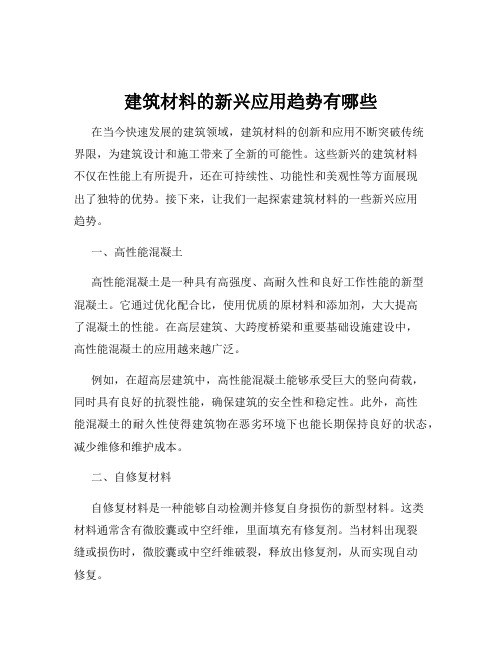
建筑材料的新兴应用趋势有哪些在当今快速发展的建筑领域,建筑材料的创新和应用不断突破传统界限,为建筑设计和施工带来了全新的可能性。
这些新兴的建筑材料不仅在性能上有所提升,还在可持续性、功能性和美观性等方面展现出了独特的优势。
接下来,让我们一起探索建筑材料的一些新兴应用趋势。
一、高性能混凝土高性能混凝土是一种具有高强度、高耐久性和良好工作性能的新型混凝土。
它通过优化配合比,使用优质的原材料和添加剂,大大提高了混凝土的性能。
在高层建筑、大跨度桥梁和重要基础设施建设中,高性能混凝土的应用越来越广泛。
例如,在超高层建筑中,高性能混凝土能够承受巨大的竖向荷载,同时具有良好的抗裂性能,确保建筑的安全性和稳定性。
此外,高性能混凝土的耐久性使得建筑物在恶劣环境下也能长期保持良好的状态,减少维修和维护成本。
二、自修复材料自修复材料是一种能够自动检测并修复自身损伤的新型材料。
这类材料通常含有微胶囊或中空纤维,里面填充有修复剂。
当材料出现裂缝或损伤时,微胶囊或中空纤维破裂,释放出修复剂,从而实现自动修复。
自修复材料在建筑领域的应用具有很大的潜力。
例如,在混凝土结构中使用自修复材料,可以延长混凝土的使用寿命,减少裂缝扩展导致的结构损坏。
此外,自修复涂料可以应用于建筑物的外墙,自动修复因风化、酸雨等因素造成的表面损伤,保持建筑物的外观美观。
三、绿色保温材料随着人们对节能环保的重视,绿色保温材料成为建筑节能领域的热门选择。
这些材料通常具有良好的保温性能,同时对环境友好,可回收利用。
比如,真空绝热板是一种高效的保温材料,其导热系数极低,能够显著降低建筑物的能耗。
气凝胶保温材料具有超轻、耐高温、高效保温等特点,在建筑保温领域的应用前景广阔。
此外,植物纤维保温材料,如麻纤维、秸秆纤维等,不仅具有良好的保温性能,还来源于可再生资源,符合可持续发展的要求。
四、智能玻璃智能玻璃能够根据外界环境条件自动调节透光率和隔热性能。
常见的智能玻璃有电致变色玻璃、热致变色玻璃和光致变色玻璃等。
建筑装修材料的应用
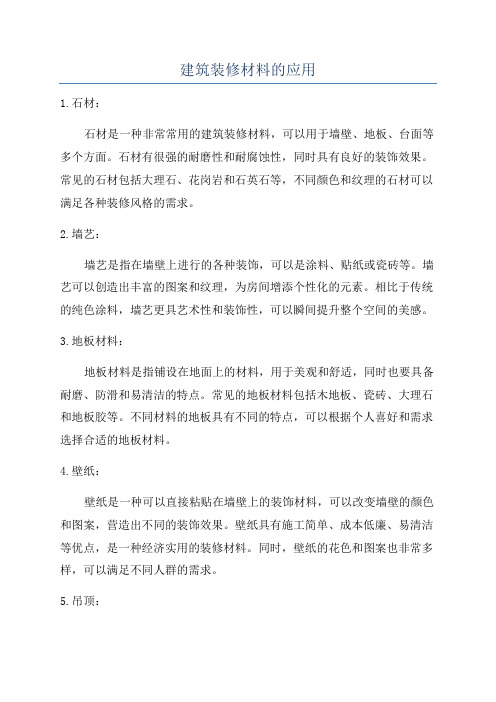
建筑装修材料的应用1.石材:石材是一种非常常用的建筑装修材料,可以用于墙壁、地板、台面等多个方面。
石材有很强的耐磨性和耐腐蚀性,同时具有良好的装饰效果。
常见的石材包括大理石、花岗岩和石英石等,不同颜色和纹理的石材可以满足各种装修风格的需求。
2.墙艺:墙艺是指在墙壁上进行的各种装饰,可以是涂料、贴纸或瓷砖等。
墙艺可以创造出丰富的图案和纹理,为房间增添个性化的元素。
相比于传统的纯色涂料,墙艺更具艺术性和装饰性,可以瞬间提升整个空间的美感。
3.地板材料:地板材料是指铺设在地面上的材料,用于美观和舒适,同时也要具备耐磨、防滑和易清洁的特点。
常见的地板材料包括木地板、瓷砖、大理石和地板胶等。
不同材料的地板具有不同的特点,可以根据个人喜好和需求选择合适的地板材料。
4.壁纸:壁纸是一种可以直接粘贴在墙壁上的装饰材料,可以改变墙壁的颜色和图案,营造出不同的装饰效果。
壁纸具有施工简单、成本低廉、易清洁等优点,是一种经济实用的装修材料。
同时,壁纸的花色和图案也非常多样,可以满足不同人群的需求。
5.吊顶:吊顶是指位于房间顶部的装饰材料,可以隐藏屋顶的杂乱和管道,并提供良好的隔热和隔音效果。
常见的吊顶材料包括石膏板吊顶、铝合金吊顶和PVC板吊顶等。
不同材料的吊顶具有不同的特点,可以根据需求选择合适的吊顶材料。
6.窗帘:窗帘是一种能够调节室内光线和保护隐私的装饰材料,常用于客厅、卧室和办公室等场所。
窗帘可以有不同的颜色和布料,具有丰富的装饰效果。
同时,窗帘不仅可以起到装饰的作用,还能够阻挡阳光和噪音,提供更好的居住环境。
总而言之,建筑装修材料在建筑装饰中起着至关重要的作用。
选择合适的装修材料能够提供良好的装饰效果、结构强度和舒适度,同时也要考虑功能性和经济性。
在装修过程中,需要根据需求和预算选择合适的装修材料,以创造出理想的居住环境。
十种常用建筑材料以及应用
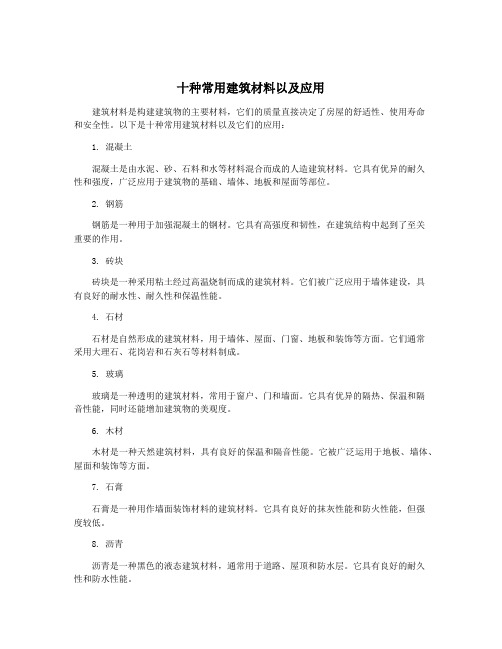
十种常用建筑材料以及应用建筑材料是构建建筑物的主要材料,它们的质量直接决定了房屋的舒适性、使用寿命和安全性。
以下是十种常用建筑材料以及它们的应用:1. 混凝土混凝土是由水泥、砂、石料和水等材料混合而成的人造建筑材料。
它具有优异的耐久性和强度,广泛应用于建筑物的基础、墙体、地板和屋面等部位。
2. 钢筋钢筋是一种用于加强混凝土的钢材。
它具有高强度和韧性,在建筑结构中起到了至关重要的作用。
3. 砖块砖块是一种采用粘土经过高温烧制而成的建筑材料。
它们被广泛应用于墙体建设,具有良好的耐水性、耐久性和保温性能。
4. 石材石材是自然形成的建筑材料,用于墙体、屋面、门窗、地板和装饰等方面。
它们通常采用大理石、花岗岩和石灰石等材料制成。
5. 玻璃玻璃是一种透明的建筑材料,常用于窗户、门和墙面。
它具有优异的隔热、保温和隔音性能,同时还能增加建筑物的美观度。
6. 木材木材是一种天然建筑材料,具有良好的保温和隔音性能。
它被广泛运用于地板、墙体、屋面和装饰等方面。
7. 石膏石膏是一种用作墙面装饰材料的建筑材料。
它具有良好的抹灰性能和防火性能,但强度较低。
8. 沥青沥青是一种黑色的液态建筑材料,通常用于道路、屋顶和防水层。
它具有良好的耐久性和防水性能。
9. 金属板材10. 人造板材人造板材是一种由纤维板、颗粒板等材料制成的建筑材料。
它们广泛应用于地板、墙面和家具等方面。
综上所述,以上十种建筑材料在建筑物的设计和建造中都发挥着重要的作用。
当选择材料时,应根据建筑本身的需要和预算情况,选择最为合适的材料。
建筑材料应用资料

建筑材料应用资料建筑材料是建筑工程中必不可少的组成部分,不仅决定了建筑物的外观和质量,还影响了其使用寿命和安全性。
本篇文章将详细介绍几种常见的建筑材料及其应用。
一、水泥砂浆1. 概述水泥砂浆是由水泥、砂子和适量的水配制而成的建筑材料。
其优点包括强度高、耐久性好、施工方便等。
常用于砌体、抹灰和混凝土结构中。
2. 应用(1)砌体施工:水泥砂浆被广泛应用于砌体墙体的施工中,可以用于砖砌和石砌。
(2)抹灰:水泥砂浆可以作为墙壁和天花板的抹灰材料,可以平整墙面并增强表面的硬度。
(3)混凝土结构:作为混凝土结构构件的粘结材料,水泥砂浆起到了连接和固定的作用。
二、砖瓦1. 概述砖瓦是建筑中经常使用的一种材料,常见的有红砖、空心砖和瓷砖等。
其特点是结构稳定、防火性能好、吸水性低等。
2. 应用(1)墙体施工:砖瓦是墙体的主要构件材料,常用于室内和室外墙面的建造。
(2)隔断墙:砖瓦也可用于室内的隔断墙,可以区分不同功能空间。
(3)地面铺装:瓷砖是常见的地面铺装材料,可以用于室内和室外的地面装饰。
三、钢筋混凝土1. 概述钢筋混凝土是一种由钢筋和混凝土组合而成的复合材料。
它具有高强度、耐久性好和施工方便等优点。
2. 应用(1)梁柱结构:钢筋混凝土常用于建筑物的梁柱结构中,可以承受大部分的水平和垂直荷载。
(2)地板和楼板:作为地板和楼板的主要材料,钢筋混凝土能够承受重压和抗震性能好。
(3)桥梁和隧道:由于钢筋混凝土的高强度和耐久性,它广泛应用于桥梁和隧道等交通工程中。
四、玻璃1. 概述玻璃是一种无机非金属材料,具有透明、坚固和耐腐蚀等特点。
在建筑中使用广泛。
2. 应用(1)窗户和门:玻璃常用于建筑物的窗户和门上,提供光线和空气的进出。
(2)幕墙:幕墙是外墙的一种装饰构造,玻璃是幕墙的重要材料之一。
(3)隔断墙和玻璃砖:玻璃可以用作办公室和商业场所的隔断墙,提供了更开放和通透的空间感。
以上介绍了建筑中常见的几种材料及其应用。
新型建筑材料的发展趋势及应用2024
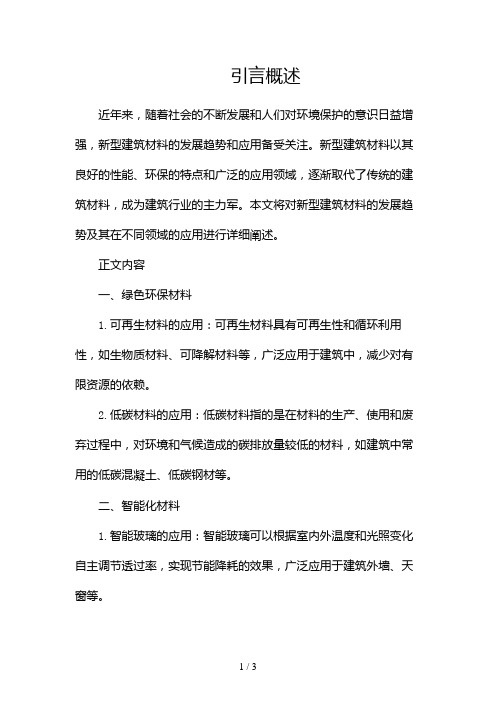
引言概述近年来,随着社会的不断发展和人们对环境保护的意识日益增强,新型建筑材料的发展趋势和应用备受关注。
新型建筑材料以其良好的性能、环保的特点和广泛的应用领域,逐渐取代了传统的建筑材料,成为建筑行业的主力军。
本文将对新型建筑材料的发展趋势及其在不同领域的应用进行详细阐述。
正文内容一、绿色环保材料1.可再生材料的应用:可再生材料具有可再生性和循环利用性,如生物质材料、可降解材料等,广泛应用于建筑中,减少对有限资源的依赖。
2.低碳材料的应用:低碳材料指的是在材料的生产、使用和废弃过程中,对环境和气候造成的碳排放量较低的材料,如建筑中常用的低碳混凝土、低碳钢材等。
二、智能化材料1.智能玻璃的应用:智能玻璃可以根据室内外温度和光照变化自主调节透过率,实现节能降耗的效果,广泛应用于建筑外墙、天窗等。
2.光催化材料的应用:光催化材料通过吸收光能和催化剂的作用,能够分解空气中的有害物质,实现空气净化效果,被广泛运用于建筑外墙涂料、屋顶材料等。
三、高效节能材料1.保温隔热材料的应用:保温隔热材料具有良好的保温性能,可减少建筑物的能耗,广泛应用于建筑的外墙、屋顶等。
2.太阳能利用材料的应用:太阳能利用材料将太阳能转化为电能或热能,实现能源的可持续利用,广泛应用于建筑的太阳能电池板、太阳能热水器等。
四、高强度耐久材料1.高性能混凝土的应用:高性能混凝土具有高强度、高耐久性和高抗裂性的特点,广泛应用于建筑的结构工程中。
2.纳米材料的应用:纳米材料具有优异的性能,如高强度、高导热、高导电等,广泛应用于建筑的新型涂料、阻燃材料等。
五、其他创新材料1.3D打印材料的应用:3D打印技术可以制造出复杂形状的建筑构件,提高施工的精度和效率,广泛应用于建筑的模型制作、构件制造等。
2.生物材料的应用:生物材料在建筑领域中,可以用作建筑结构材料、装饰材料等,具有良好的生态性能和气候适应性。
总结新型建筑材料的发展趋势及应用日益受到重视。
常见的建筑材料及其应用场景
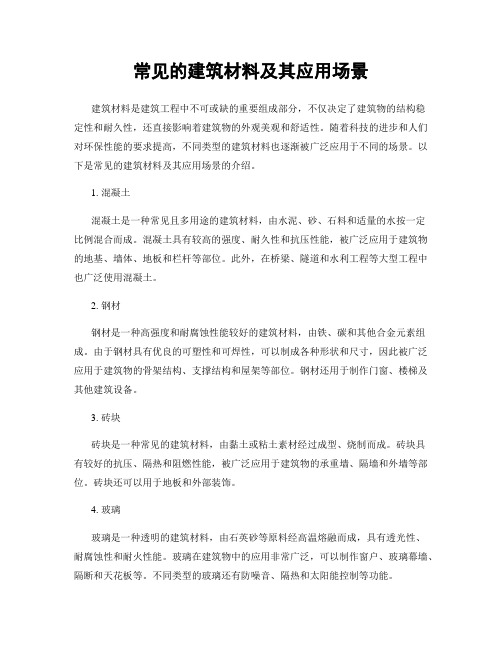
常见的建筑材料及其应用场景建筑材料是建筑工程中不可或缺的重要组成部分,不仅决定了建筑物的结构稳定性和耐久性,还直接影响着建筑物的外观美观和舒适性。
随着科技的进步和人们对环保性能的要求提高,不同类型的建筑材料也逐渐被广泛应用于不同的场景。
以下是常见的建筑材料及其应用场景的介绍。
1. 混凝土混凝土是一种常见且多用途的建筑材料,由水泥、砂、石料和适量的水按一定比例混合而成。
混凝土具有较高的强度、耐久性和抗压性能,被广泛应用于建筑物的地基、墙体、地板和栏杆等部位。
此外,在桥梁、隧道和水利工程等大型工程中也广泛使用混凝土。
2. 钢材钢材是一种高强度和耐腐蚀性能较好的建筑材料,由铁、碳和其他合金元素组成。
由于钢材具有优良的可塑性和可焊性,可以制成各种形状和尺寸,因此被广泛应用于建筑物的骨架结构、支撑结构和屋架等部位。
钢材还用于制作门窗、楼梯及其他建筑设备。
3. 砖块砖块是一种常见的建筑材料,由黏土或粘土素材经过成型、烧制而成。
砖块具有较好的抗压、隔热和阻燃性能,被广泛应用于建筑物的承重墙、隔墙和外墙等部位。
砖块还可以用于地板和外部装饰。
4. 玻璃玻璃是一种透明的建筑材料,由石英砂等原料经高温熔融而成,具有透光性、耐腐蚀性和耐火性能。
玻璃在建筑物中的应用非常广泛,可以制作窗户、玻璃幕墙、隔断和天花板等。
不同类型的玻璃还有防噪音、隔热和太阳能控制等功能。
5. 木材木材是一种传统的建筑材料,具有良好的绝缘性能和装饰性能。
木材被广泛应用于建筑物的结构、地板、门窗和家具等部位。
由于木材易于加工和施工,同时也符合环保要求,因此在低层建筑和木质结构的建筑物中得到了广泛应用。
6. 石材石材是一种天然的建筑材料,包括大理石、花岗岩、石灰石和板岩等。
石材具有高强度、耐腐蚀和防火性能,同时还具有优雅的外观和装饰效果。
石材广泛应用于建筑物的外墙、地面、台阶和装饰等部位。
7. 外墙材料外墙材料是用于建筑物外墙装饰和保护的建筑材料。
常见的外墙材料包括涂料、瓷砖、石材、铝塑板和复合材料等。
建筑材料的创新应用有哪些
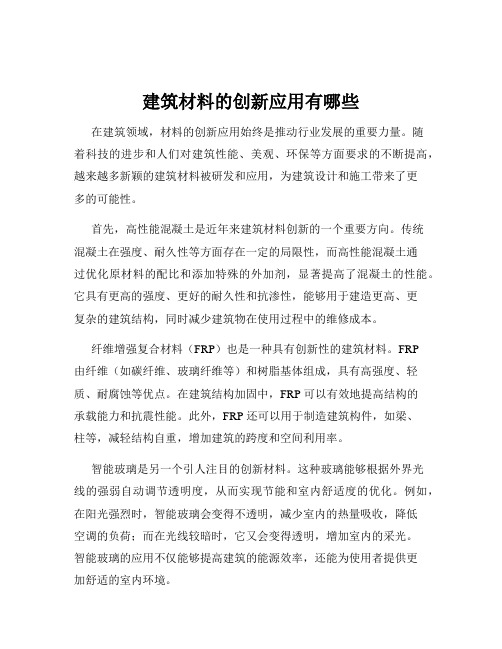
建筑材料的创新应用有哪些在建筑领域,材料的创新应用始终是推动行业发展的重要力量。
随着科技的进步和人们对建筑性能、美观、环保等方面要求的不断提高,越来越多新颖的建筑材料被研发和应用,为建筑设计和施工带来了更多的可能性。
首先,高性能混凝土是近年来建筑材料创新的一个重要方向。
传统混凝土在强度、耐久性等方面存在一定的局限性,而高性能混凝土通过优化原材料的配比和添加特殊的外加剂,显著提高了混凝土的性能。
它具有更高的强度、更好的耐久性和抗渗性,能够用于建造更高、更复杂的建筑结构,同时减少建筑物在使用过程中的维修成本。
纤维增强复合材料(FRP)也是一种具有创新性的建筑材料。
FRP由纤维(如碳纤维、玻璃纤维等)和树脂基体组成,具有高强度、轻质、耐腐蚀等优点。
在建筑结构加固中,FRP 可以有效地提高结构的承载能力和抗震性能。
此外,FRP 还可以用于制造建筑构件,如梁、柱等,减轻结构自重,增加建筑的跨度和空间利用率。
智能玻璃是另一个引人注目的创新材料。
这种玻璃能够根据外界光线的强弱自动调节透明度,从而实现节能和室内舒适度的优化。
例如,在阳光强烈时,智能玻璃会变得不透明,减少室内的热量吸收,降低空调的负荷;而在光线较暗时,它又会变得透明,增加室内的采光。
智能玻璃的应用不仅能够提高建筑的能源效率,还能为使用者提供更加舒适的室内环境。
自修复材料的出现为建筑的长期维护提供了新的解决方案。
这类材料具有自我修复微小裂缝和损伤的能力,延长了建筑材料的使用寿命。
例如,一些自修复混凝土中含有特殊的微生物或胶囊,当混凝土出现裂缝时,微生物会产生碳酸钙来填充裂缝,或者胶囊破裂释放出修复剂来修复损伤。
3D 打印建筑材料的应用正在改变建筑施工的方式。
通过逐层堆积材料来构建建筑结构,3D 打印可以实现复杂形状的建筑设计,减少材料浪费和施工时间。
目前,已经有使用 3D 打印混凝土、聚合物等材料建造的房屋和建筑构件。
绿色环保材料在建筑中的应用越来越广泛。
新材料在建筑工程中的新应用
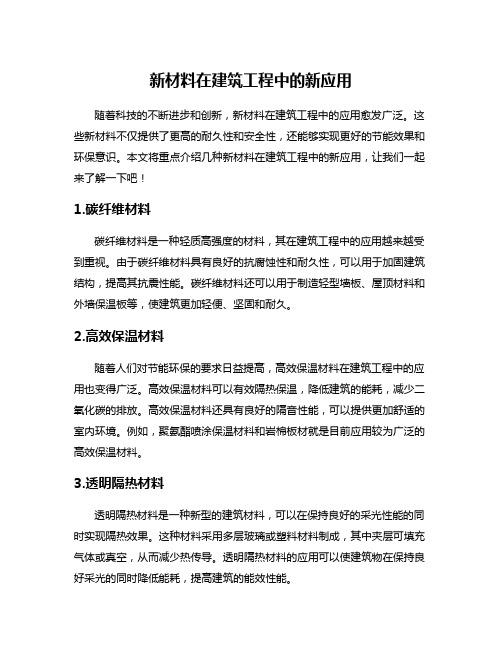
新材料在建筑工程中的新应用随着科技的不断进步和创新,新材料在建筑工程中的应用愈发广泛。
这些新材料不仅提供了更高的耐久性和安全性,还能够实现更好的节能效果和环保意识。
本文将重点介绍几种新材料在建筑工程中的新应用,让我们一起来了解一下吧!1.碳纤维材料碳纤维材料是一种轻质高强度的材料,其在建筑工程中的应用越来越受到重视。
由于碳纤维材料具有良好的抗腐蚀性和耐久性,可以用于加固建筑结构,提高其抗震性能。
碳纤维材料还可以用于制造轻型墙板、屋顶材料和外墙保温板等,使建筑更加轻便、坚固和耐久。
2.高效保温材料随着人们对节能环保的要求日益提高,高效保温材料在建筑工程中的应用也变得广泛。
高效保温材料可以有效隔热保温,降低建筑的能耗,减少二氧化碳的排放。
高效保温材料还具有良好的隔音性能,可以提供更加舒适的室内环境。
例如,聚氨酯喷涂保温材料和岩棉板材就是目前应用较为广泛的高效保温材料。
3.透明隔热材料透明隔热材料是一种新型的建筑材料,可以在保持良好的采光性能的同时实现隔热效果。
这种材料采用多层玻璃或塑料材料制成,其中夹层可填充气体或真空,从而减少热传导。
透明隔热材料的应用可以使建筑物在保持良好采光的同时降低能耗,提高建筑的能效性能。
4.3D打印材料近年来,3D打印技术的发展为建筑工程带来了诸多创新。
通过使用尺寸精确的建筑材料,可以通过3D打印技术快速、精准地制造建筑构件。
这种新材料不仅可以节约建筑时间和成本,还可以实现建筑形式和设计的个性化。
3D打印材料还可以利用可回收的材料,实现建筑工程的可持续发展。
新材料在建筑工程中的新应用为建筑行业带来了巨大的发展机遇。
碳纤维材料、高效保温材料、透明隔热材料和3D打印材料等的应用,不仅提高了建筑物的安全性和耐久性,还实现了节能环保的目标。
随着科技的不断进步,相信新材料将会在建筑工程中继续发挥重要作用,为我们的生活带来更多的便利和舒适。
常用建筑原材料种类及应用

常用建筑原材料种类及应用常用建筑原材料种类及应用建筑原材料是指用于建筑施工的各种材料,包括水泥、混凝土、砖石、钢筋、玻璃、木材、涂料等。
以下是常用建筑原材料的种类及其应用:1. 水泥:水泥是建筑工程中常见的材料之一,常用于制作混凝土、砌块、抹灰等。
其主要成分是硅酸盐和铝酸盐,具有良好的抗压强度和耐久性,适用于各种建筑结构。
2. 混凝土:混凝土是由水泥、砂子、骨料和水按一定比例配制而成,具有较高的强度和耐久性,广泛应用于建筑工程中的地基、框架和墙体结构。
3. 砖石:砖石是建筑中常见的建筑材料,有多种类型,如红砖、空心砖、固体砖等。
砖石具有良好的抗压和保温性能,适用于墙体和隔墙的建造。
4. 钢筋:钢筋是一种钢材,用于加强混凝土结构的强度和韧性。
在建筑工程中使用钢筋可以增加结构的抗震和抗拉能力。
5. 玻璃:玻璃是一种透明的无机材料,广泛应用于建筑工程中的窗户、幕墙、隔断等。
玻璃具有隔热、隔音、透光等特性,能够提供良好的视觉效果和室内采光。
6. 木材:木材是一种天然的建筑材料,常用于建造屋檐、楼梯、地板等。
木材具有良好的抗压、抗拉强度,同时也能提供良好的保温和隔音效果。
7. 墙面涂料:墙面涂料是一种用于涂刷建筑墙面的材料,常用于室内和室外的装饰。
墙面涂料有多种类型,如乳胶漆、油漆、壁纸等,能够改善室内空气质量,增加墙面的美观度。
8. 地板材料:地板材料是一种用于铺设地面的材料,常用于房间的地板装饰。
常用的地板材料有木地板、石材地板、地毯等,能够提供舒适的踏感和丰富的装饰效果。
9. 屋面材料:屋面材料是一种用于建筑物顶部覆盖的材料,常用于屋顶的保温和防水。
常见的屋面材料有瓦片、金属瓦、石英瓦等,具有良好的防水和耐久性。
10. 绝缘材料:绝缘材料是一种用于保温和隔热的材料,常用于建筑外墙和屋顶的绝缘。
常见的绝缘材料有岩棉、玻纤绝缘棉、聚苯乙烯等,能够有效提高建筑物的能源利用效率。
以上是常用建筑原材料的种类及其应用。
建筑工程新材料的研发与应用

建筑工程新材料的研发与应用随着科技的不断进步和环保意识的提高,建筑工程领域对新材料的需求越来越迫切。
新材料在建筑工程中的应用不仅可以提高建筑物的性能,降低能耗,还能减少环境污染。
本文将介绍一些建筑工程新材料的研发与应用。
一、保温节能材料1.硅酸盐保温材料(泡沫玻璃)泡沫玻璃是一种优良的保温材料,具有良好的隔热、防火和吸声性能。
它主要由废弃玻璃、发泡剂和调节剂组成,通过高温熔融、发泡和冷却制成。
泡沫玻璃在建筑工程中可用于外墙、屋顶、地面等部位的保温隔热。
2.陶瓷保温材料陶瓷保温材料具有高热稳定性、低导热系数和良好的抗压强度。
它们主要由陶瓷纤维和保温砂浆组成,可用于建筑外墙、屋顶、地面等部位的保温隔热。
3.胶粉聚苯颗粒胶粉聚苯颗粒是一种复合保温材料,由聚苯颗粒、胶粉和发泡剂组成。
它具有优良的保温、防火和吸声性能,广泛应用于建筑外墙、屋顶、地面等部位的保温隔热。
4.钢丝网采水泥泡沫板(舒乐板)舒乐板是一种复合保温材料,由钢丝网、水泥和泡沫组成。
它具有较高的抗压强度、抗拉强度和保温性能,适用于建筑外墙、屋顶、地面等部位的保温隔热。
5.挤塑板XPSXPS板是一种优良的保温材料,由聚苯乙烯树脂、发泡剂和添加剂组成。
它具有较低的导热系数、良好的抗压强度和耐老化性能,广泛应用于建筑外墙、屋顶、地面等部位的保温隔热。
二、绿色建筑节能新材料1.生态混凝土生态混凝土是一种环保型建筑材料,主要由水泥、矿物掺合料、骨料、水和生态添加剂组成。
它具有高强度、高耐久性和良好的抗渗性能,适用于建筑结构、桥梁、道路、隧道等工程。
2.绿色涂料绿色涂料是一种环保型涂料,主要由水性树脂、颜料、分散剂、乳化剂和添加剂组成。
它具有低挥发性有机物(VOC)排放、高固含量、良好的附着力和耐候性能,适用于建筑内外墙面、屋顶、家具等部位的涂装。
3.高效节能玻璃高效节能玻璃是一种具有优良隔热、保温、降噪和透光性能的建筑玻璃。
它主要由低辐射玻璃、中空玻璃、真空玻璃等组成,适用于建筑门窗、幕墙等部位。
建筑工程材料应用

建筑工程材料应用建筑工程是指根据设计文献和图纸要求,利用建筑材料和施工设备,在特定的工地上进行的建筑施工活动。
而建筑工程材料则是指用于建筑施工的各种材料,包括但不限于水泥、钢筋、砖块、木材等。
在建筑工程中,材料的选择和应用至关重要,它直接影响到建筑工程的质量和工期。
因此,对于建筑工程材料的应用,我们需要有一定的了解和掌握。
水泥是建筑工程中最常用的材料之一。
它具有良好的可塑性和粘接性,能够将各种材料紧密连接在一起。
水泥的应用范围广泛,可以用于地基和基础的浇筑,也可以用于砌筑墙体和铺设地板。
在使用水泥时,需要根据具体情况选择适当的水泥种类和配合比,以保证工程的强度和稳定性。
钢筋是建筑工程中承重结构的重要组成部分。
它具有高强度和良好的韧性,能够承受大的拉力和压力。
钢筋的应用主要是在混凝土结构中,通过钢筋与混凝土的配合使用,提高结构的承载能力和抗震性能。
在施工过程中,需要严格按照设计要求进行钢筋的布置和固定,以确保结构的稳定和安全。
砖块是建筑工程中常用的墙体材料。
它具有较高的强度和良好的隔热性能,适用于各种气候条件下的建筑施工。
砖块的应用范围广泛,可以用于砌筑墙体、地面和顶板等。
在选择砖块时,需要考虑材料的强度、吸水性和保温性能等因素,以满足建筑结构和使用功能的要求。
木材是建筑工程中常用的结构材料之一。
它具有较高的强度和良好的加工性能,适用于各种建筑结构和装饰工程。
木材的应用主要是在木结构和木质装饰方面,如梁柱、楼板、门窗等。
在使用木材时,需要注意防腐处理和防火处理,以延长木材的使用寿命并提高建筑的安全性。
此外,建筑工程材料的应用还包括保温材料、防水材料、装饰材料等。
保温材料主要用于提高建筑结构的保温性能,包括保温板、保温棉等;防水材料主要用于防止建筑结构受潮和渗水,包括防水涂料、防水卷材等;装饰材料主要用于美化建筑表面,增强建筑的美观性和功能性,包括瓷砖、油漆、墙布等。
综上所述,建筑工程材料的应用对于工程质量和工期具有重要影响。
建筑材料的性能和应用

建筑材料的性能和应用建筑是人类生活的基础,而建筑材料无疑是建筑的“骨骼”和“血肉”。
建筑材料的性能和应用,直接影响着建筑的质量、寿命、安全、美观等多方面。
一、常见建筑材料及其性能1. 水泥砂浆水泥砂浆是建筑施工中最常用的建筑材料之一,用于粘结各种建筑材料,如砖、石、混凝土等。
水泥砂浆的主要性能是:硬度高、强度大、耐久性好、防水、防火等。
2. 石材石材是建筑中常用的一种材料,常用于室内地面、墙面和室外广场、电梯井、门窗等部位。
常见的石材有大理石、花岗岩、石灰岩等。
石材的主要性能是:耐磨、坚固耐用、防潮、防滑、美观等。
3. 木材木材是建筑中古老的一种材料,常用于建筑的梁、柱、屋架、地板、墙板等。
木材的主要性能是:良好的保温性、吸音性、具有美观的纹理和色泽、适应性好等。
4. 钢材钢材是建筑中使用广泛的一种材料,常用于结构件、管道、电缆桥架等。
钢材的主要性能是:强度高、耐久性强、可塑性好、可重复使用等。
5. 玻璃玻璃是建筑中用于隔墙、窗户、门、幕墙等的常见材料之一。
玻璃的主要性能是:透明、采光好、保温、隔音、装饰等。
二、建筑材料的应用1. 墙体材料建筑的外墙和内墙多用砖、混凝土、钢材等。
目前,随着科技的不断发展,新型墙体材料也在不断涌现,如保温隔热材料、3D 打印材料、复合材料等。
2. 屋面材料屋面材料多用钢板、瓦、防水材料等。
其中,瓦是使用最广泛的一种屋面材料,有瓦种类多、价格低廉、美观等优点。
3. 地面材料地面材料多用石材、木材、瓷砖等。
近年来,人造材料的应用也越来越广泛,如地板、地毯等。
4. 窗户材料常见的窗户材料包括木材、铝合金、塑钢等。
其中,塑钢窗户由于其较好的隔热性、防水性、隔音性等优点,被广泛应用于建筑中。
5. 结构材料结构材料多用钢材、混凝土等。
近年来,新型结构材料的应用也越来越广泛,如复合材料、高分子材料等,这些新型材料具有重量轻、强度高、耐腐蚀等特点,可以大大提高建筑的质量和寿命。
三、建筑材料使用时需注意的问题1. 建筑材料的选择与搭配建筑材料的选择应根据建筑的性质和功能选择相应的材料,材料的数量和使用方式应搭配合理,满足建筑需要,达到最佳效果。
建筑材料的分类及应用

建筑材料的分类及应用建筑材料是房屋建设的核心基础。
它的特性和性质对房屋的质量和强度有着非常重要的影响。
建筑材料的分类和应用是建设领域中的一个非常重要的知识点,下面我们来一起学习一下吧。
1、常见建筑材料的分类及其特点(1)水泥:用于建筑物的主要结构基础。
水泥有很多种,水泥的特点在于它的韧性和强度。
水泥有慢干和快干之分,用途略有不同。
(2)钢铁:主要用于钢结构建筑和各种钢筋的制造。
钢铁的特点在于其强度和韧性,极大的提升了建筑物的整体强度。
(3)砖料:用于各种墙面、建筑、地板等。
砖料的材质可以分为红砖,水泥砖和轻质砖。
红砖的强度较高,但是较为耗材料。
水泥砖则用水泥和沙子制作而成,相对便宜和环保,轻质砖则通常用于保暖。
(4)木材:主要用于地板,屋顶等部分。
木材的特点在于它的美观和轻便,比较适于家具和装饰。
2、建筑材料的应用(1)水泥水泥在建筑行业中有非常广泛的应用。
它的用途包括墙面装饰、支撑和混凝土制作。
在墙面上的使用方式可以是涂刷和铺贴。
(2)钢铁钢铁的应用通常是钢筋混凝土的制作。
钢筋混凝土是目前用于建筑结构最为常见的方式之一。
通过混凝土和钢筋的完美结合,使得建筑物的强度得到极大提升。
(3)砖料砖料可以应用于建筑的墙体、地面和屋顶等部分。
其制作成本相对较低,因此是建筑行业中的重要选材之一。
(4)木材木材应用最为普遍的领域是地板和屋顶的装饰。
同时它的弹性和温馨感也被广泛的运用到室内装饰和家具中。
3、未来建筑材料的发展趋势在未来,建筑材料的发展将会越来越趋向于高新材料、绿色环保材料。
其中值得关注的是:(1)玻璃:越来越多的建筑以玻璃材料为主要外墙建造,并且在节能保温等方面更加出色。
(2)新型保温材料:保温材料对于建筑物的能耗和居住环境造成的影响非常大。
新型保温材料将越来越受到重视。
(3)再生建材:一些废旧建筑材料的再利用已经受到了重视,特别是建筑垃圾的回收利用。
总结:建筑材料的分类和应用很复杂,很多依赖于当前的工程、建筑标准和建筑形态。
建筑工程中的新材料应用

建筑工程中的新材料应用建筑工程是一个复杂的领域,需要应用各种新颖的技术和材料。
随着科技的不断发展,人们对于新材料的需求也不断增长。
在建筑工程中,新材料的应用有着重要的意义,不仅可以提高建筑的质量和安全性,还可以降低成本,节约资源。
本文将介绍建筑工程中常见的新材料应用及其特点。
一、玻璃钢材料玻璃钢材料是一种高强度、耐腐蚀、轻质、易加工的新材料,适用于建筑工程领域的许多应用,如桥梁结构、建筑外壳、储水罐和管道。
其强度和刚性超过了传统材料,而且耐腐蚀性能极佳。
玻璃钢材料还具有绿色环保的特点,可以减少建筑生产过程中产生的废弃物和对环境的污染。
二、新型保温材料在建筑工程中,保温材料起着重要的作用。
新型保温材料种类繁多,如聚苯乙烯泡沫板、岩棉板、珍珠岩板、聚氨酯泡沫板等。
这些材料具有良好的隔热性和隔音性能,同时还具有一定的防火性能。
其中,聚苯乙烯泡沫板是目前应用最广泛的一种保温材料,价格相对便宜,而且施工方便快捷。
三、新型建筑涂料在建筑工程中,涂料不仅是起到美化建筑物的作用,还可以保护建筑材料。
而传统建筑涂料存在环境污染、有毒有害等问题,因此新型建筑涂料得到了广泛应用。
新型建筑涂料种类繁多,例如:无机涂料、水性涂料、环保涂料等。
这些涂料不含有害成分,具有环保、防火、耐污染等特点。
四、新型预制构件材料随着城市建设规模的不断扩大,建筑施工量也持续增加,预制构件逐渐成为建筑行业趋势。
新型预制构件材料不仅节省人力、物力成本,而且在保质保量方面也更有保障。
同时,新型预制构件材料具有优异的力学性能,例如高强度、耐久性等。
由此,新型预制构件材料成为建筑行业中的重要材料。
五、新型地材地面材料在建筑中占据着非常重要的位置,而新型地材的发展在建筑中也起到了重要的作用。
常见的新型地材有硅酸盐、木地板、PVC等。
木地板是一种绿色环保的地面材料,有良好的耐磨性、防水性,而且使用寿命长。
硅酸盐地面材料具有耐磨损、耐压、不易滑、防污染的特点,同时还能够保持地面的自然通气性。
新型建筑材料在施工中的应用

新型建筑材料在施工中的应用首先,新型建筑材料在施工中的应用主要体现在以下几个方面:1.高性能混凝土:高性能混凝土具有抗渗、抗裂、抗冻融、耐久性好等优点,可以提高建筑的整体性能和使用寿命。
在施工中,高性能混凝土可以用于地下隧道、高层建筑、重要桥梁等工程的建设,使结构更加牢固可靠。
2.高新技术陶瓷:高新技术陶瓷具有高强度、高硬度、高耐磨、高耐温等特点,可以应用于建筑的装饰、地面铺设、幕墙等方面。
通过使用高新技术陶瓷,可以增加建筑的美观度和观感,同时提高建筑的耐候性和耐久性。
3.环保建材:环保建材是指具有环保性、可持续发展性的建材,如竹木材料、节能环保型玻璃等。
这些材料可以减少对自然资源的消耗,降低建筑工程的能耗,减少环境污染。
在施工中,使用环保建材可以提高建筑的绿色指数,符合社会的可持续发展要求。
4.具有新型功能的建材:随着科技的进步,新型建筑材料还具有很多新的功能,如保温隔热、声音隔离、防火等。
这些功能性建材在施工中可以发挥重要作用,提高建筑的舒适性和安全性。
以上只是新型建筑材料在施工中的应用的一部分,下面将对一些常见的新型建筑材料在施工中的应用进行详细介绍。
1.高性能混凝土的应用:高性能混凝土的抗渗性能好,可以用于地下隧道的施工。
在地铁、行车隧道等施工中,使用高性能混凝土可以大大减少地下水渗漏,提高隧道的安全性和耐久性。
2.超高性能混凝土的应用:超高性能混凝土以其高强度、高耐久性等特点,被广泛应用于桥梁的施工中。
在大跨度桥梁的建设中,使用超高性能混凝土可以减少梁体的自重,提高桥梁的承载能力和抗震性能。
3.新型玻璃的应用:新型玻璃材料具有优良的透光性、保温性能、隔音性能等特点,可以应用于建筑的幕墙、隔断、窗户等方面。
在大型写字楼、商业中心等建筑中,使用新型玻璃可以提供更加舒适的办公环境,降低能源消耗。
4.具有自洁性能的建材的应用:具有自洁功能的建材,如自洁玻璃、自洁瓷砖等,可以减少建筑物外表的污染,降低清洁成本。
建筑材料的种类与应用
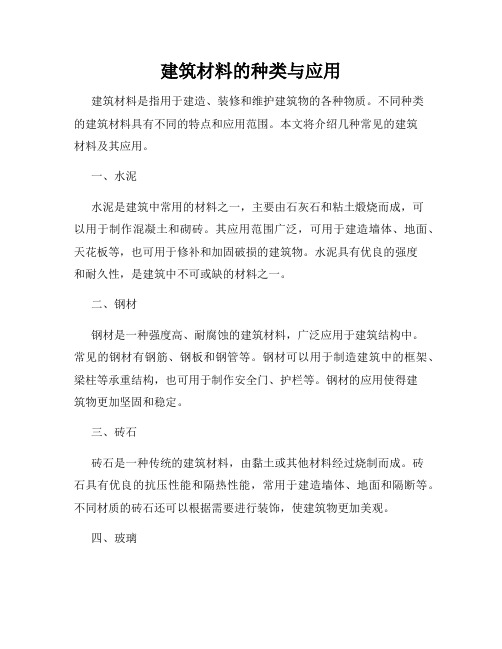
建筑材料的种类与应用建筑材料是指用于建造、装修和维护建筑物的各种物质。
不同种类的建筑材料具有不同的特点和应用范围。
本文将介绍几种常见的建筑材料及其应用。
一、水泥水泥是建筑中常用的材料之一,主要由石灰石和粘土煅烧而成,可以用于制作混凝土和砌砖。
其应用范围广泛,可用于建造墙体、地面、天花板等,也可用于修补和加固破损的建筑物。
水泥具有优良的强度和耐久性,是建筑中不可或缺的材料之一。
二、钢材钢材是一种强度高、耐腐蚀的建筑材料,广泛应用于建筑结构中。
常见的钢材有钢筋、钢板和钢管等。
钢材可以用于制造建筑中的框架、梁柱等承重结构,也可用于制作安全门、护栏等。
钢材的应用使得建筑物更加坚固和稳定。
三、砖石砖石是一种传统的建筑材料,由黏土或其他材料经过烧制而成。
砖石具有优良的抗压性能和隔热性能,常用于建造墙体、地面和隔断等。
不同材质的砖石还可以根据需要进行装饰,使建筑物更加美观。
四、玻璃玻璃是一种广泛应用于建筑中的材料,主要由二氧化硅、碱金属等经过高温熔化而成。
玻璃具有透明、光滑、坚硬的特点,可以用于制作建筑物的窗户、门、墙体等。
不同类型的玻璃还具有不同的特性,如安全玻璃具有防爆和防弹的功能,隔音玻璃可以降低噪音。
五、木材木材是一种常见的建筑材料,具有轻质、可塑性好的特点。
木材广泛用于建造墙体、地板、屋顶等部位。
木材还可以进行加工和装饰,使其更具美观性。
然而,木材的易燃性和不耐腐蚀的特点也限制了其在某些场合的应用。
六、陶瓷陶瓷是一种耐高温、耐腐蚀的建筑材料,由粘土和其他添加剂烧制而成。
陶瓷具有良好的绝缘性能和装饰性能,可以用于制作建筑物的地砖、洗手盆等。
陶瓷还可以根据需要进行着色和装饰,增加建筑物的美观度。
总结:建筑材料的种类繁多,每一种材料都有其独特的特点和应用范围。
在建筑中选择适当的材料至关重要,既要考虑材料的性能和功能,又要考虑成本和环境因素。
通过合理选择和应用建筑材料,可以构建出安全、耐久且美观的建筑物。
现代建筑材料的应用

现代建筑材料的应用随着科技的发展和社会的进步,现代建筑材料在建筑领域中的应用日益广泛。
它们不仅拥有更好的性能和功能,还具备更高的可持续性和环境友好性。
本文将探讨现代建筑材料的应用,以及它们对建筑行业和环境的影响。
一、高性能混凝土高性能混凝土是一种优质的建筑材料,它具有高耐久性、高强度和高抗渗性。
通过使用合适的材料配比和精细的混凝土技术,高性能混凝土能够满足各种复杂结构的需求。
例如,在大跨度结构中,高性能混凝土能够提供更好的抗震性能和减少结构变形的能力。
此外,高性能混凝土还可以用于修复和加固老旧建筑物。
传统混凝土结构容易受到外界环境的侵蚀和损坏,而高性能混凝土具有更好的抗腐蚀和耐久性能,能够延长建筑物的使用寿命。
二、节能玻璃节能玻璃是一种能够降低建筑物能源消耗的创新建筑材料。
它通过在玻璃表面覆盖一层特殊的薄膜,实现了对太阳辐射和热量的有效隔离。
这种特殊的膜材料能够反射一部分太阳辐射和热量,从而减少了建筑内部的热量积累,使室内环境更加凉爽。
节能玻璃不仅可以节约空调能耗,在冬季时还可以阻挡室内热量的散失,提高建筑的供暖效果。
此外,节能玻璃还具有良好的隔音性能,可以减少噪音的干扰,提高室内的居住舒适度。
三、可再生建筑材料可再生建筑材料是一类对环境友好且能够循环利用的材料。
随着人们对环境保护意识的提高,可再生建筑材料在建筑行业中的应用越来越受到重视。
例如,竹材作为一种常见的可再生建筑材料,具有生长周期短、吸湿排湿性能好等特点。
它可以用于建筑结构的支撑和装饰,不仅具备良好的承重能力,还能够提供自然的美感。
再如,利用废弃物和回收材料制造建筑材料也是一种有效的可再生方式。
废弃物砖块、再生钢材等都可以通过适当的加工和处理,用于建筑物的建造,减少资源的浪费。
四、绿色屋顶绿色屋顶是一种能够改善城市生态环境的建筑材料应用方式。
它指通过在建筑物屋顶铺设一层或多层绿色植物,形成生态系统,实现城市生态的恢复和退化的抑制。
绿色屋顶可以起到保温和隔热的作用,降低建筑物的能耗。
建筑材料应用

建筑材料应用建筑材料是建筑行业中必不可少的一部分,对于建筑质量和建筑外观起着至关重要的作用。
本文将从建筑材料的种类、应用领域以及对建筑质量的影响等方面进行论述。
一、建筑材料的种类建筑材料的种类繁多,根据材料的性质和用途不同,可以分为结构材料、装饰材料和保温材料三大类。
1. 结构材料结构材料是建筑结构的主要组成部分,包括钢筋混凝土、砖石、木材和钢铁等。
钢筋混凝土以其强度高、耐用性好等特点,在建筑结构中得到广泛应用。
砖石则常用于墙体的搭建,其质地坚固,透气性好,是一种理想的建筑结构材料。
木材被广泛用于房屋的建造和装修,其质轻、隔热性好,在节能环保的建筑中大显身手。
钢铁在高层建筑和桥梁等大型工程中应用广泛,其强度高、抗震性好,为建筑物提供重要的结构支撑。
2. 装饰材料装饰材料主要用于建筑物的装修和美化,包括涂料、地板、瓷砖等。
涂料能够提供建筑物的色彩和保护表面,根据用途不同可以分为内墙涂料和外墙涂料。
地板材料有木地板、石材地板和地板砖等,它们不仅能够提供良好的踏感和舒适度,还能增加建筑物的整体美感。
瓷砖作为一种常见的装饰材料,广泛应用于墙面和地面的装修,其防潮、耐磨的特性受到了广大消费者的认可。
3. 保温材料保温材料主要用于建筑物的保温和隔热,包括保温板、保温砂浆和保温棉等。
保温板能够有效隔断建筑物内外温度的传导,提高建筑物的保温性能。
保温砂浆在施工过程中能够填充墙体和屋顶的空隙,增加建筑物的保温效果。
保温棉以其保温性能优良,具有柔软性和隔音性,被广泛应用于建筑物的保温工程。
二、建筑材料在不同领域的应用建筑材料在不同领域具有各自的应用特点,下面以住宅建筑、商业建筑和公共建筑为例进行展开讨论。
1. 住宅建筑在住宅建筑中,结构材料、装饰材料和保温材料都有着重要的应用。
钢筋混凝土作为主要的结构材料,能够提供房屋的整体稳定性和安全性。
装饰材料则能够为住宅营造出不同的风格和氛围,提高居住舒适度。
保温材料在住宅建筑中起到了隔热保温的重要作用,能够保证室内温度稳定,提高节能效果。
建筑材料应用及介绍
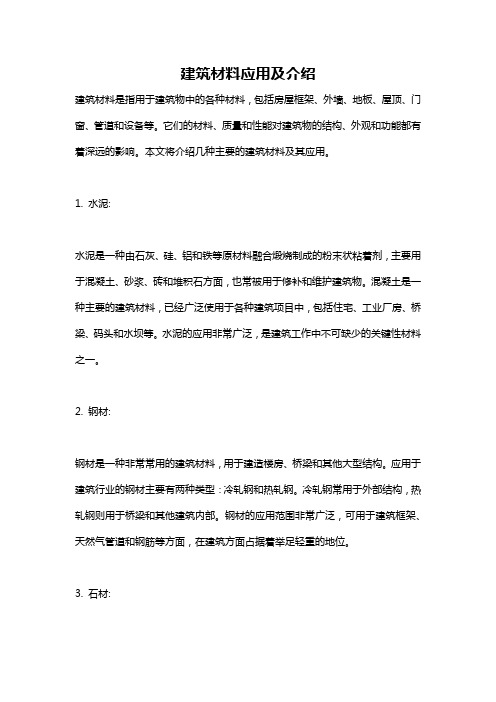
建筑材料应用及介绍建筑材料是指用于建筑物中的各种材料,包括房屋框架、外墙、地板、屋顶、门窗、管道和设备等。
它们的材料、质量和性能对建筑物的结构、外观和功能都有着深远的影响。
本文将介绍几种主要的建筑材料及其应用。
1. 水泥:水泥是一种由石灰、硅、铝和铁等原材料融合煅烧制成的粉末状粘着剂,主要用于混凝土、砂浆、砖和堆积石方面,也常被用于修补和维护建筑物。
混凝土是一种主要的建筑材料,已经广泛使用于各种建筑项目中,包括住宅、工业厂房、桥梁、码头和水坝等。
水泥的应用非常广泛,是建筑工作中不可缺少的关键性材料之一。
2. 钢材:钢材是一种非常常用的建筑材料,用于建造楼房、桥梁和其他大型结构。
应用于建筑行业的钢材主要有两种类型:冷轧钢和热轧钢。
冷轧钢常用于外部结构,热轧钢则用于桥梁和其他建筑内部。
钢材的应用范围非常广泛,可用于建筑框架、天然气管道和钢筋等方面,在建筑方面占据着举足轻重的地位。
3. 石材:石材是一种天然的建筑材料,其由岩石、矿物和其他天然元素组成。
常用的石材有大理石、花岗岩、砂岩和石膏等。
石材的用途广泛,可用于建造立面、台阶、楼梯和地面等方面,使建筑物看起来更加雅致和有质感。
4. 玻璃:玻璃是一种透明的结构材料,常用于建造窗户、门、天花板、隔板和幕墙等。
玻璃的质量和不同的厚度可以根据不同的需要进行调节,以便在建筑物内为光线的进出提供各种不同的选择。
5. 木材:木材是一种常见的建筑材料,用于建造地板、墙壁和梁等。
它的用途非常广泛,在不同的建筑项目中都有着大量应用,其所具备的良好物理性质和环保性质使其成为人们喜爱的材料之一。
总的来说,在建筑材料应用中,水泥、钢材、石材、玻璃和木材都有着各自的优点和特点,可以为不同的建筑项目提供适用的解决方案。
人们利用这些材料来建造出高质量、现代化的建筑物,以增加其美观、实用和耐用性,同时也为人们的日常生活提供了更加舒适和便利的环境。
- 1、下载文档前请自行甄别文档内容的完整性,平台不提供额外的编辑、内容补充、找答案等附加服务。
- 2、"仅部分预览"的文档,不可在线预览部分如存在完整性等问题,可反馈申请退款(可完整预览的文档不适用该条件!)。
- 3、如文档侵犯您的权益,请联系客服反馈,我们会尽快为您处理(人工客服工作时间:9:00-18:30)。
建筑材料的应用建筑材料的应用适当有效的建筑材料是限制富有经验的结构工程师成就的主要原因之一。
早期的建筑者几乎都只使用木材,石头,砖块和混凝土。
尽管铸铁在修建埃及的金字塔中已被人们使用, 但是把它作为建筑材料却由于大量熔炼它比较困难而被限制。
然而,受到把铸铁作为建筑材料和在大量融炼它的能力的两者对其双重需要的影响。
John Smeaton,一个英国土木工程师, 在十八的世纪中时,是第一广泛地使用铸铁作为建筑材料的。
在1841之后,可锻金属被发展成更可靠的材料并且广泛地被应用。
尽管可锻金属优于铸铁,但仍有很多结构破坏从而需要有更可靠的材料。
钢便是这一需要的答案。
1856年的贝色麦转转炉炼钢法和后来发展的马丁平炉炼钢法的发明使以竞争的价格形成了生产建筑用钢并且兴起了建筑用钢在下个百年的快速发展。
钢的最严重缺点是它容易被氧化而需要被油漆或一些其他的适当涂料保护。
当钢被用于可能发生火灾环境时, 钢应该包围在一些耐火的材料中, 例如石料或混凝土。
通常,钢的组合结构不易被压碎除非是在冶金成分不好,低温的不利组合, 或空间压力存在的情况下。
建筑用铝仍然不广泛被在土木工程结构中用虽然它的使用正在稳定地增加。
藉着铝合金作为一个适当的选择和对其进行热处理,可获得各式各样的强度特性。
一些合金所展现的抗压强度特性相似于钢, 除线形弹性模量大约是7,000,000 牛/平方厘米,相当于刚的三分之一。
质量轻和耐氧化是铝的两个主要优点。
因为它的特性对热处理是非常敏感的,当铆接或焊接铝的时候,一定要小心仔细。
一些技术已为制造预制铝组合配件及形成若干的美丽的设计良好的外型结构的铝制结构而发展起来。
组合房屋配件制造的一般程序藉由螺栓连接,这似乎是利用建筑用铝的最有前途的方法。
加强和预应力混凝土是主要的建筑材料。
天然的水泥混凝土已经被使用长达数世纪之久。
现代的混凝土建筑兴起于十九世纪中叶,尽管人造水泥被Aspidin,1825年申请了专利. 虽然一些建筑者和工程师在十九世纪后期用钢筋混凝土作实验, 但作为一种建筑材料它占统治地位是在二十世纪初期。
后五十年钢筋混凝土结构设计和建筑得到迅速发展,早期在法国的Freyssinet 和比利时的Magnel被大量使用。
素混凝土作为建筑材料有一个非常严重的缺点:就是它的抗拉强度非常有限,只是它的抗压强度的十分之一。
素混凝土不仅受拉破坏是脆性破坏,而且受压破坏也是在没有多大变形预兆的情况下发生的准脆性破坏。
(当然,在钢筋混凝土建筑中,可以得到适当的延性)。
只有进行适当的养护和合理的选择并且掺加适当的混合天加剂,否则霜冻破坏能严重的损害混凝土。
在长期荷载作用下混凝土在选择设计受压情况方面要仔细考虑。
在硬化的时候和它的早期养护下,混凝土收缩占主要地位, 因此需要添加适当地比例的添加剂而且用适当的建筑技术来控制。
藉由所有的这些可能的严重缺点,工程师已经试着为各种实际结构设计建立美丽的,持久的,和经济的钢筋混凝土结构。
这是藉着设计尺寸和钢筋排列安排的谨慎选择,和适当的水泥的发展已经趋于同步,适当添加剂混合比例, 混合配置, 而且养护技术和建筑方法,仪器的快速发展。
混凝土具有多种用途,其组成材料广泛可取,并且能非常方便地浇制成满足强度及功能要求的形状,同时,随着新型预应力混凝土、预制混凝土以及普通混凝土施工方法令人兴奋的进一步改善和发展的潜力,这些因素综合起来使得混凝土在绝大多数结构中有着比其他材料更大的竞争力。
在现代由钢和加强钢筋的使用量在建筑结构中的增加,木材在建筑期间主要地已经被撤离到附属的、暂时的和次要的结构中使用,成为建筑材料的次要成员。
然而, 现代的技术在最后六十年中已经有使木材作为建筑材料恢复生气的迹象,由大量的改良了木材的加工方法,各种不同的处理方法增加了木材的耐久性,而且叠片木材连同使用黏结技术的革命使得木材的性能有了更好的保证。
各向同性的胶合板是最广泛使用的压层胶合板,随着技术的发展,压层胶合板已经发展成为特定的结构材料并对混凝土和钢造成了强大的竞争力。
将来可能发展的材料是工程塑料和稀有金属及他们的合金,如铍,钨,钽,钛,钼,铬,钒和铌。
有许多不同的塑料可以用,而且这些材料所展现的力学性能在很大的范围内改变。
我比较设计方案选择适当的可能的塑料材料是可能的。
对塑料的使用受经验的限制。
一般而言,塑料一定要与空气隔离。
设计的这一个方面要求主要是对塑料结构元素在使用中的考虑。
塑料被应用的最有希望的潜能之一是嵌板和贝壳型结构。
叠片或夹心嵌板已经被用于此种结构以鼓励未来建筑大量应用这一个类型材料。
另一种引起注意的材料由纤维或像粒子的胶结加筋的微粒组成的合成物材料正在开发。
虽然一种由玻璃或塑料胶结材料组成的玻璃纤维加筋合成物已经被用长达数年之久, 但是他们很可能退落为次要的结构材料。
加筋混凝土是另一个积极地被学习而且发展的混合料。
一些实验正在工作情况下进行。
实验主要内容为钢和玻璃纤维,但是大部份的使用经验在钢纤维方面比较先进。
The application of constructional materialThe availability of suitable structural materials is one of the principal limitations on the accomplishment of an experienced structural engineer. Early builders depended almost exclusively on wood, stone, brick, and concrete. Although iron had been used by humans at least since the building of the Egyptian pyramids, use of it as a structural material was limited because of the difficulties of smelting it in large quantities. With the industrial revolution, however, came both the need for iron as a structural material and the capability of smelting it in quantity, John Smeaton , an English civil engineer , the first to use cast iron extensively as a structural material in the mid-eighteenth century. After 1841, malleable iron was developed as a more reliable material and was widely used. Whereas malleable iron was superior to cast iron, there were still too many structural failures and there was a need for a more reliable material.Steel was the answer to this demand. The invention of the Bessemer converter in 1856 and the subsequent development of the Siemens-Martin open-hearth process for making steel made it possible to produce structural steel at competitive prices and triggered the tremendous developments and accomplishments in the use of structural steel over the next hundred years. The most serious disadvantage of steel is that it oxidizes easily and must be protected by paint or some other suitable coating. When steel is used in an enclosure where a fire could occur, the steel members must be encased in a suitable fire-resistant enclosure such as masonry, concrete. Normally, steel members will not fail in a brittle manner unless an unfortunate combination of metallurgical composition, low temperature, and bi-or triaxial stress exists. Structural aluminum is still not widely used in civil engineering structures, though its use is steadily increasing.By a proper selection of the aluminum alloy and its heat treatment, a wide variety of strength characteristics may be obtained. One of the alloys exhibit stress strain characteristic similar those of structural steel, except that the modulus of elasticity for the initial linearly elastic portion is about 700,000kg/cm*cm or about one-third that of steel. Lightness and resistance to oxidation are, of course, two of the major advantages of aluminum. Because its properties are very sensitive to its heat treatment, care must be used when riveting or welding aluminum. Several techniques have been developed for prefabricating aluminum subassemblies that can be readily erected and both together in the field to form a number of beautiful and well designed shell structures. This general proceral procedure of prefabrication and held assembly by bolting seems to be the most promising way of utilizing structural aluminum. Reinforced and priestesses concrete share with structural material. Natural cement concretes have been used for centuries.Modern concrete construction dates from the middle of the nineteenth century, though artificial Portland cement was patented by Aspidin, an Englishman, about 1825. Although 3 several builders and engineers experimented with the use of steel reinforced concrete in the last half of the nineteenth century, its dominant use as a building material dates from the earlydecades of the twentieth century. The last fifty years have seen the rapid and vigorous development of pre-stressed concrete design and construction, founded largely on early work by Freyssinet in France and Magnel in Belgium. Plain(unreinforced)concrete not only is a heterogeneous material but also has one very serious defect as a structural material, namely, it’s very limited tensile strength, which is only of the order of one-tenth its compressive strength. Not only is tensile failure in concrete of a brittle type, but likewise compression failure occurs in a relatively brittle fashion without being preceded by the forewarning of large deformations. (Of course, in reinforced-concrete construction, ductile behavior can be obtained by proper selection and arrangement of the reinforcement.) Unless proper care is used in the selection of aggregates and in the mixing and placing of concrete, frost action can cause serious damage to concrete masonry. Concrete creeps under long-term loading to a degree that must be considered carefully in selecting the design stress conditions. During the curing process and its early life, concrete shrinks a significant amount, which to a degree can be controlled by properly proportioning the mix and utilizing suitable construction techniques. With all these potentially serious disadvantages, engineers have learned to design and build beautiful, durable, and economical reinforced-concrete structures for practically all kinds of structural requirements. This has been accomplished by careful selection of the design dimensions and the arrangement of the steel reinforcement, development of proper cements, selection of proper aggregates and mix proportions, careful control of mixing, placing, and curing techniques and imaginative development of construction methods, equipment and procedures. The versatility of concrete, the wide availability of its component materials, the unique ease of shaping its form to meet strength and functional requirements, together with the exciting potential of further improvements and development of not only the newer pre-stressed and precast concrete construction but also the conventional reinforced concrete construction, combine to make concrete a strong competitor of other materials in a very large fraction of structures.In modern times, with the increased use of steel and inforced concrete construction, wood has been relegated largely to accessory use during construction, to use in temporary and secondary structures, and to use for secondary members of permanent construction. Modern technology in the last sixty years has revitalized wood as a structural material, however, by developing vastly improved timber connectors, various treatments to increase the durability of wood, and laminated wood made of thin layers bonded together with synthetic glues using revolutionary gluing techniques. Plywood with essentially nondirectional strength properties is the most widely used laminated wood, but techniques have also been developed for building large laminated wood members that for certain structures are competitive with concrete and steel. Materials with future possibilities are the engineering plastics and the exotic metals and their alloys, such as beryllium, tungsten, tantalum, titanium, molybdenum, chromium, vanadium, and niobium. There are many different plastics available, and the mechanical properties exhibited by this group of materials vary over a wide range that encompasses the range of properties available among the more commonly used structural materials. Thus in many specific design applicationsit is possible to select a suitable plastic material for an alternative design. Experience with the use of plastics outdoors is limited. Generally speaking, however, plastics must be protected from the weather. This aspect of design is therefore a major consideration in the use of plastics for primary structural elements. One of the most promising potential used of plastics is for panel and shell-type structures. Laminated or sandwich panels have been used in ` 4 such structures with encouraging results that indicate an increased use in this type of construction in the future. Another materials development with interesting possibilities is that of composites consisting of a matrix reinforced by fibers or fiber like particles. Although glass-fiber-reinforced composites with a glass or plastic matrix have been used for years, they appear to have much broader possibilities for a large variety of secondary structural components. Fiber-reinforced concrete is another composite being actively aplications are being observed under service conditions. Experiments have been conducted with both steel and glass fibers, but most of the ervice experience has been with steel fibers.。
